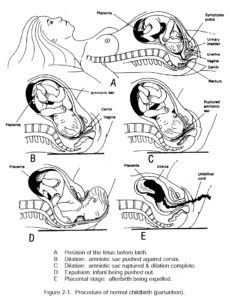If all the signs are that the baby is about to be born and there is no time to get the mother to the hospital, proceed in this manner:
a. Preparation for Delivery. Prepare as follows:
(1) Try to find an area of maximum privacy and cleanliness.
(2) Allow another woman or the patient’s husband to be present to reassure the patient.
(3) Be calm and reassuring.
(4) Position the patient on her back and place a folded sheet or drape under her buttocks.
(5) Immediately, start an IV with a liter of saline at a keep open (TKO) rate.
(6) An assistant should move to the patient’s head and be prepared to turn her head to one side in case she vomits.
(7) Make an oxygen tank and suction available.
(8) Wash your hands thoroughly before you open the obstetrical kit.
ATTENTION
If no obstetrical kit is available, make an improvised kit by gathering the following:
- Plastic bag or other waterproof material.
- Clean sheets or towels (to use as drapes).
- Pan or container (to collect the placenta).
- Rubber bulb syringe (to suction the newborn and clear its airway).
- Baby blankets (to wrap the baby in).
- Material to tie or clamp the cord.
- Sanitary napkins.
- Scissors.
- Gloves (if available).
(9) Put on sterile gloves. Drape the patient with four towels so that everything but the vaginal opening is thoroughly covered.
(10) Encourage the mother to relax and take slow, deep breaths through her mouth.
(11) Reassure the mother and explain to her what you are doing as you go along.
b. Delivering the Baby. Follow this procedure (figure 2-1):

(1) When the baby’s head begins to emerge from the vagina, place your right hand (or left hand if you are left-handed) over the emerging head and exert very gentle pressure. This will allow the head to come out smoothly. Place your other hand under the baby’s head. Supporting the baby’s head is essential. This support will prevent a strong, unexpected uterine contraction from suddenly expelling the baby from the vagina.
CAUTION: DO NOT attempt to pull the baby from the vagina.
(2) If the membranes cover the infant’s head after the head emerges, tear the sac (the membranes) with your fingers or forceps to permit the amniotic fluid to escape and enable the baby to breathe.
(3) Make sure the umbilical cord is not wrapped around the baby’s neck. If the cord is around the baby’s neck, gently try to slip the cord over the baby’s shoulder and head.
(4) Deliver the baby’s shoulders and body, supporting the head at all times.
(5) Avoid touching the mother’s anus during delivery.
(6) Record the time of birth.
